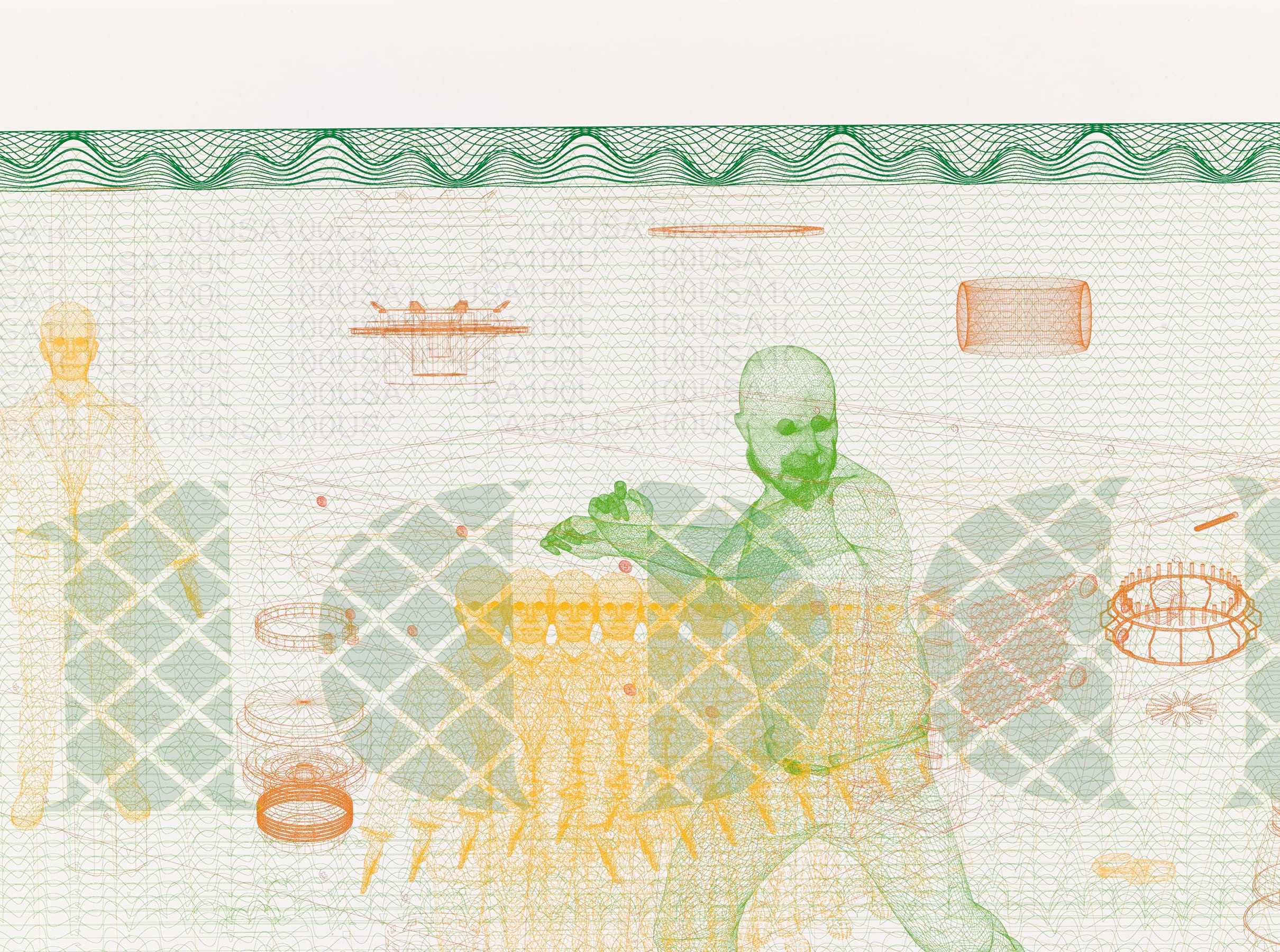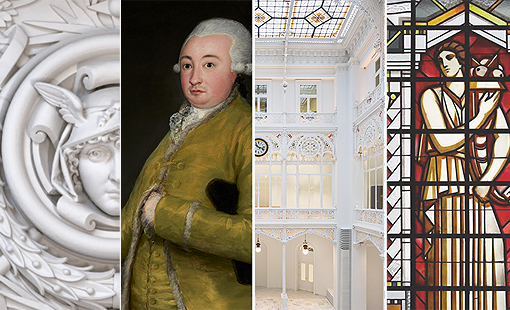
The Banco de España opens its doors to the public to view some of its rich heritage
As part of its firm commitment to provide access to the valuable historical and artistic heritage built up by the institution in its long history, spanning over two hundred years, the Banco de España is launching a programme of guided tours![]() starting this October.
starting this October.
The building on Plaza Cibeles has been a listed historical monument since 1999 (classed as an asset of cultural interest). The new tours take in some of the most iconic architectural spaces, including the imperial staircase, the main banking hall – now repurposed as a library – the recently restored collection hall and the trading floor![]() . It also takes in other working and function areas of architectural or artistic value, including the boardroom and the ceremonial dining rooms.
. It also takes in other working and function areas of architectural or artistic value, including the boardroom and the ceremonial dining rooms.
Visitors will also have a chance to see an extensive selection of the artworks that form the core of the bank's collection, including paintings by Francisco de Goya of the governors of the Banco Nacional de San Carlos – forerunner of the current Banco de España – and Annie Leibovitz's twin photo-portrait of King Felipe VI and Queen Letizia which, following its presentation at the bank's The Tyranny of Chronos exhibition, is now on display in the boardroom.
TYPES OF TOUR
Three different types of tour are on offer, catering to different audiences and all covering the same spaces and contents.
- Open Doors at weekends. October 2025 to June 2026: Fridays, 4–8 pm; Saturdays and Sundays, 10 am–2 pm and 4–8 pm. Conducted by specialist staff, these tours last 90 minutes. Maximum group size is 30 people. Book here![]() .
.
- Visits for school groups. October 2025 to June 2026: Wednesdays and Thursdays, 4 pm. Targeted at groups of pupils from middle school (3rd and 4th year ESO), high school, vocational education and university. Led by specialist staff, the tours are tailored to the specific academic levels and requirements of each group. Book here![]() .
.
- Tours by bank volunteers. October 2025 to June 2026, Mondays and Tuesdays 4 pm. The tour, led by the bank's own staff (retired and current), offers an insight not only into the history of the building and the art it houses, but also its living role as a place of work and symbolism Book here![]() .
.
A brochure has been published with all the information you might need to organise the visit. It can be downloaded for free from the Publications section of this website.
The 'Open Doors' scheme represents a significant boost to the bank's cultural outreach and mediation policy. It will run continuously for nine months, with tours scheduled throughout the week, including weekends and public holidays. The scheme is forecast to quintuple the number of tour groups visiting the building. It reflects the bank's desire to build a stable, accessible and professionalised tour programme, extending the scope of the bank's cultural activities and providing information on its collection and heritage items to a larger and more diverse audience.
HOW TO GET HERE
Metro: Banco de España Station - Line 2
Bus: Plaza de Cibeles. Lines 1, 2, 5, 9, 10, 14, 14, 15, 20, 27, 27, 34, 37, 45, 51, 52, 53, 74, 146, 150
Suburban rail (Cercanías). Recoletos Station - Lines C1, C2, C7, C8 and C10
Bicimad (Bicycle rental). 20 (Banco de España) - 29 (Marqués de Cubas)
RESTORATION OF THE COLLECTION HALL
The Banco de España's new programme of guided tours includes the former Collection Hall, recently restored by Paredes Pedrosa Arquitectos. The hall is notable for its architecture in the Moorish Revival style, employed to exceptional effect by architect Eduardo de Adaro, who, together with Severiano Sainz de la Lastra, designed the nineteenth century offices on Plaza Cibeles.
In view of the historical and artistic value of the space, the restoration work has been closely overseen by the Ministry of Culture and Sports and Madrid City Council's Committee for the Protection of Historical, Artistic and Natural Heritage.
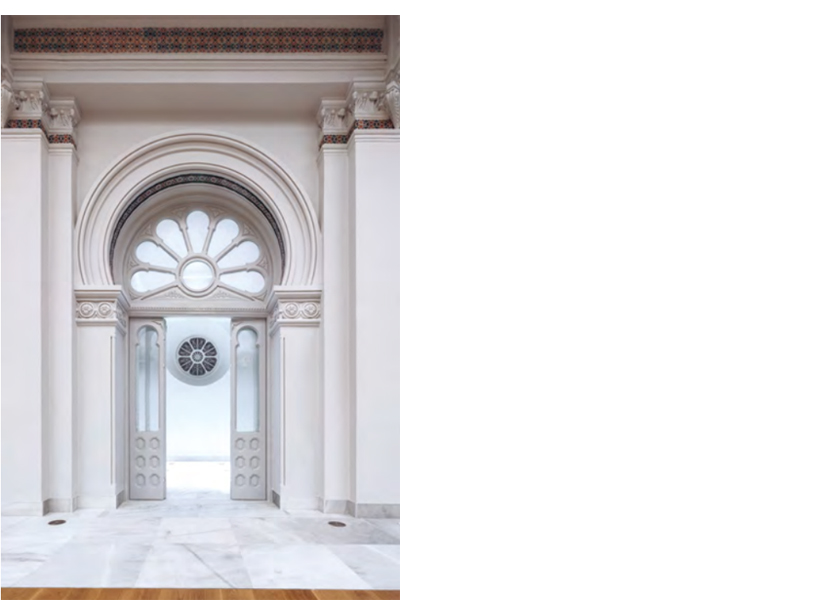 Collection Hall
Collection Hall
Adaro's design offers an interesting reinterpretation of Spanish Moorish architecture, employing features from the culture of Al-Andalus, including horseshoe arches and the decorative geometric tiles, some clearly inspired by the Alhambra palace in Granada. The handmade ceramics, highly prized at the time, were combined with the use of the most advanced technology of the period: the cast iron structure and the translucent glass ceiling, letting natural light filter in from the old banking hall – now the library – located immediately above. This arrangement created a functional and symbolic link between the two spaces.
The collection hall offers a surprising fusion between the image of a genuinely Spanish historical architecture and an industrial architecture that took its references from contemporary technical and industrial advances elsewhere in Europe.
ARCHITECTURE. Unity and diversity of styles for a historic site
The Banco de España's head offices stand at the intersection of Paseo del Prado and Calle de Alcalá. In addition to the collection hall, the building boasts a number of spaces that emphasise its exceptional role, organically combining the palatial and the industrial, the technological and the artisanal, the functional and the academic, tradition and innovation.
Designed by Eduardo de Adaro and Severiano Sainz de la Lastra![]() , it is considered to be one of the prime examples of nineteenth-century eclectic architecture in Spain. Since it first opened in 1891, it has undergone a number of alterations. For the interior of the extension added between 1927 and 1936, José Yárnoz Larrosa
, it is considered to be one of the prime examples of nineteenth-century eclectic architecture in Spain. Since it first opened in 1891, it has undergone a number of alterations. For the interior of the extension added between 1927 and 1936, José Yárnoz Larrosa![]() adopted the language of art deco. Rafael Moneo’s
adopted the language of art deco. Rafael Moneo’s![]() 2006 annexe added new meeting rooms and an assembly hall whilst respecting and underscoring the original design. As a result, the current appearance of the Banco de España is the result of a consistent process of architectural evolution that respects the stylistic unity of the whole.
2006 annexe added new meeting rooms and an assembly hall whilst respecting and underscoring the original design. As a result, the current appearance of the Banco de España is the result of a consistent process of architectural evolution that respects the stylistic unity of the whole.
The main banking hall is one of the most iconic spaces in the original building. Like nearly all the metalwork employed in the construction, the cast iron for the structure came from the Mieres Factory. Another highly emblematic space is the imperial staircase ascending from the main entrance hall off Paseo del Prado, which features one of the most important sets of decorative and iconographic features in the building. They include a spectacular set of symbolist-style stained glass panels![]() especially designed by Mayer of Munich, one of Europe's most prestigious stained-glass manufacturers in the second half of the nineteenth century.
especially designed by Mayer of Munich, one of Europe's most prestigious stained-glass manufacturers in the second half of the nineteenth century.
A key legacy of José Yárnoz Larrosa's extension is the trading floor![]() , designed as a well-lit functional area that would serve as the hub of banking activity. The Navarrese architect looked abroad for his inspiration, designing the decor in the popular art deco style. A particularly fine example is the large clock in the centre of the hall, with its imposing quadrangular base housing a state-of-the-art extraction system.
, designed as a well-lit functional area that would serve as the hub of banking activity. The Navarrese architect looked abroad for his inspiration, designing the decor in the popular art deco style. A particularly fine example is the large clock in the centre of the hall, with its imposing quadrangular base housing a state-of-the-art extraction system.
In keeping with the tradition of illuminating the Bank's public spaces with natural light, the room is dominated by a large stained glass window, designed by Maumejean of Madrid, with a set of images depicting progress, human labour and the advances of modern industry. José Yárnoz Larrosa's extension also led to the creation of one of the building's most famous landmarks: the Gold Vault. Situated 35 meters below the trading floor, it contains the gold reserves of the Spanish state and is considered to be one of the most secure vaults in the world.
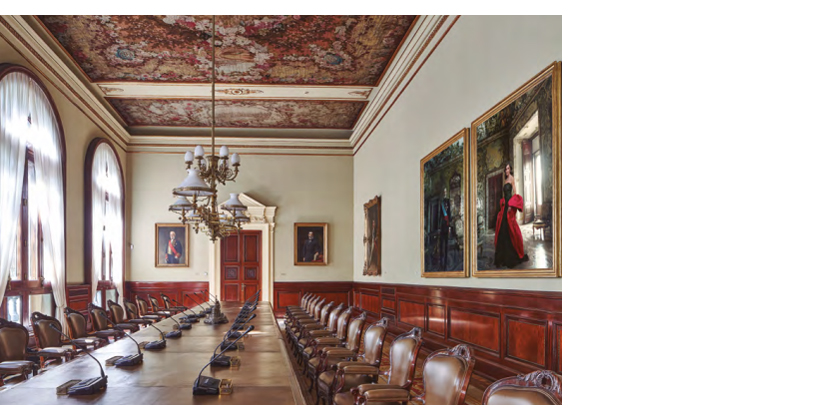 Boardroom
Boardroom
As well as these iconic areas, the tour also includes other working and ceremonial areas of architectural or artistic value. They include the boardroom and the ceremonial dining rooms, associated with executive and ceremonial activities, which house an important part of the institution's art collection.
THE COLLECTION. From the Enlightenment to The Present Day
With items amassed during its almost 250 years of history, the Banco de España Collection contains around 4,000 works, including paintings, sculptures, drawings, photographs, prints and a wide range of decorative items, such as tapestries, carpets, timepieces and furniture.
The collection dates back to the institution's origins at the height of the Spanish Enlightenment, when the Banco de San Carlos commissioned the young Francisco de Goya and other prominent artists of the day to paint its first governors. Thus began a tradition that would ultimately develop into one of the most consistent threads running through the Bank's collection, its portrait gallery, which contains pictures of many of its managers and governors, as well as royalty and heads of state from each period.
The gallery houses over a hundred works. In addition to the eight paintings by Goya, they include portraits by artists such as Mariano Salvador Maella, Vicente López Portaña, Federico de Madrazo, Ignacio Zuloaga and Joaquín Sorolla. There are also some more recent portraits by artists such as Isabel Quintanilla (the first female artist from whom the Bank commissioned a portrait) and Carmen Laffón. The two latest additions, by Annie Leibovitz, are the first photographs in the portrait collection.
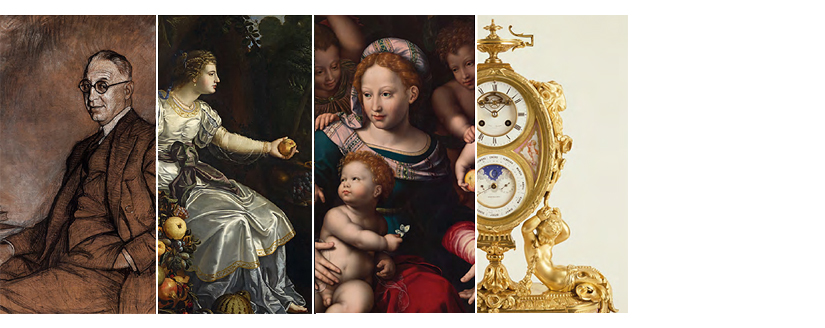 Ignacio Zuloaga y Zabaleta: Alejandro Fernández de Araoz, 1936 (detail) | Juan van der Hamen y León: Pomona and Vertumnus, 1626 (detail) | Cornelis van Cleve: Madonna of the Lily, ca. 1550 (detail) | Peña y Sobrino; Mantel clock with garniture, ca. 1860 (detail). Banco de España Collection
Ignacio Zuloaga y Zabaleta: Alejandro Fernández de Araoz, 1936 (detail) | Juan van der Hamen y León: Pomona and Vertumnus, 1626 (detail) | Cornelis van Cleve: Madonna of the Lily, ca. 1550 (detail) | Peña y Sobrino; Mantel clock with garniture, ca. 1860 (detail). Banco de España Collection
Since the restoration of democracy in 1977, the collection has grown considerably, with a particular focus on acquiring Spanish art from the mid-twentieth century to the present day. Since the bank's entry into the Eurosystem, a large number of works by foreign artists have also been added, primarily from Latin America and Europe, the two regions with which the Bank has closest ties. Around eighty percent of the Bank's collection consists of contemporary artworks. The tours now being organised will take in a selection of these works, which are a testament to the Banco de España's commitment to reflect new and changing trends.
